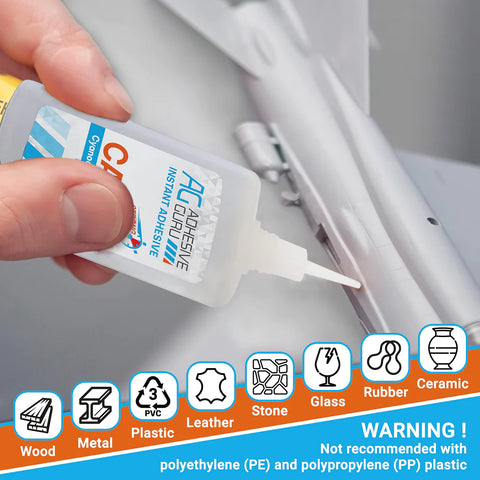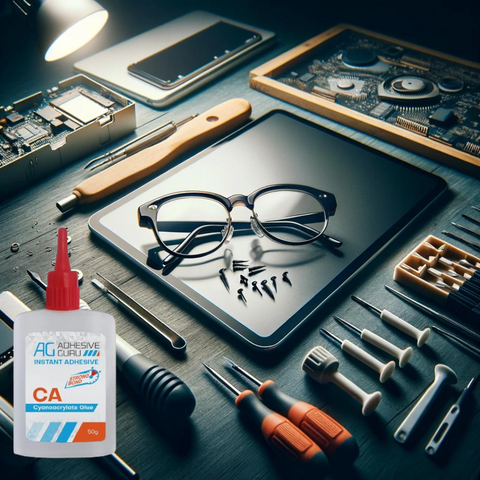The Ultimate Guide to Using Super Glue for Quick Fixes
In the event of a sudden breakage or emergency repair, super glue is the choice of most people. Also known as cyanoacrylate adhesive, it is a suitable solution for a wide range of materials, providing fast and strong bonding. In this comprehensive guide, you will learn about the properties, uses and application recommendations of super glue.


Accidents are inevitable in life and things can break suddenly. Whether it's a cracked vase or the sole of a shoe breaking off, it requires quick solutions. This is where Adhesive Guru super glue comes to your aid.
Understanding Super Glue
What is Super Glue?
Super glue is an adhesive that bonds surfaces together rapidly and forms a strong, durable connection. It is commonly used in various industries and household applications for its quick-setting properties and reliability.
How Does Super Glue Work?
Super glue works through a process called polymerization. When exposed to moisture, it undergoes a chemical reaction that transforms it from a liquid state to a solid state. This reaction occurs rapidly, creating a strong bond between the surfaces being joined.
Choosing the Right Super Glue
Selection of Materials
Not all superglues are the same. Some work better for specific materials. To get good results, choose an adhesive that is suitable for the materials you will be using.
Adhesion Strength
Super glues come in different strengths. Choosing the right glue for your repair is a matter of thinking about what you are gluing and how strong it needs to be.
Considering Drying Time
Different superglues have different drying times. Some stick immediately, while others may take a few minutes to dry. When you use CA glue with an activator, the bonding time is much shorter and it usually sticks immediately. If you need an urgent repair, choose Adhesive Guru activator. This way you can make a quick and effective repair according to your needs.
This interest may you: How to Use CA Glue with Activator: A Comprehensive Guide
Preparing for Application
Surface Preparation
Before using super glue, it is very important to prepare the surfaces for successful adhesion. Make sure that the areas to be glued are clean, dry and free of substances that may interfere with adhesion, such as oil and dirt. This will help the adhesive to adhere better.
Safety Precautions
Super glue is a strong adhesive and it is important to handle it carefully. Always read the manufacturer's instructions and take the necessary safety precautions, such as wearing protective gloves and working in a well-ventilated area.

Applying Super Glue
Applying a Small Amount
When applying super glue, a small amount is usually sufficient. Apply a small drop of adhesive to a surface, as using excessive amounts of adhesive can lead to uneven and messy joints, as well as longer drying times.
Ensuring Proper Alignment
Align the surfaces correctly before joining. Super glue bonds quickly on contact, so there is little time for correction. Double check the alignment to avoid incorrect repairs.
A Few Tips on Super Glue Usage
Temperature and Humidity Considerations
The strength of a super glue bond can be influenced by temperature and humidity. Super glue achieves optimal results in a warm, dry environment. Try to avoid applying it in extremely cold or damp conditions, as these can extend drying times and diminish the strength of the bond.
Storing Super Glue Correctly
Proper storage can extend the life of your super glue. Keep it in a cool, dry place and ensure the cap is tightly sealed after each use to prevent the glue from drying out or clogging the nozzle.
Surface Compatibility Check
Before applying super glue, make sure it's suitable for the materials you're bonding. Some super glues are specialized for certain materials. Always test on a small, inconspicuous area first to ensure compatibility and to avoid damaging your items.
Handling Glue Emergencies
Be prepared for any accidents by having acetone or nail polish remover on hand. These can help dissolve super glue in case it bonds to the skin or an unintended surface. Remember to use these substances cautiously and in a well-ventilated area.

Quick Fixes with Super Glue
Repairing Broken Objects
Super glue is ideal for fixing broken objects made of materials like ceramics, glass, or plastic. Its strong bonding properties ensure a reliable repair that can withstand everyday use.
Reattaching Delicate Parts
Whether it's a loose handle on a mug or a detached corner of a wooden frame, super glue can help you reattach delicate parts with ease. Apply the glue precisely and hold the components together until the bond sets.
Fixing Shoe Soles
If your shoe sole has detached, super glue can provide a temporary fix until you can get it professionally repaired. Apply the glue evenly along the detached area, press firmly, and allow sufficient curing time before wearing the shoes again.
Leather Fixes
Using super glue on leather can revolutionize the quick repair of items like shoes and belts. First, make sure the leather surface is clean and dry. Then, apply a thin layer of super glue to one side, and firmly press the pieces together. Super glue dries quickly, so ensure the edges are properly aligned before joining. This method is effective for small tears or separations. However, remember that the glue becomes hard after curing, so it’s better to use it on parts of the item that don't require flexibility.
Mending Jewelry
For jewelry repairs, super glue can get the job done without the need for a jeweler. It is ideal for fixing fallen stones or detached pieces. Before applying the glue, wipe the relevant part of the jewelry thoroughly with alcohol. Then, apply a small amount of glue only where needed and set the pieces in place. Do it meticulously, making sure that excess glue does not spoil the aesthetics of the jewelry. In this way, you can repair your jewelry quickly and effectively.
Plumbing Fixes
Super glue can be useful for minor plumbing repairs such as sealing small leaks in PVC pipes or joints. Turn off the water supply and dry the area thoroughly before application. Apply it around the leaking section and allow it to dry completely before turning the water back on. Although it provides a temporary fix, it is important to follow a professional's permanent solution if necessary.

Electronic Repairs
In the field of electronics, superglue can be used to fix cables or repair plastic parts such as cracked cases or broken buttons. Make sure the electronic device is switched off and completely disconnected from any power source before application. Use only a very small amount of adhesive to prevent leakage into electronic components that could cause damage. Allow the glue to dry completely before reassembling or reactivating the device.

Automotive Fixes
In automotive repairs, super glue can be used for minor fixes like attaching loose interior trim or mending broken plastic components. Ensure the area is clean and dry before application. While it offers a quick fix, for parts under high stress or temperature, seek professional repair.
Woodworking
Super glue is beneficial in woodworking for repairing small cracks or chips in wood, or for temporarily holding pieces together while other adhesives dry. It can also be used as a finish by sealing porous end grains. Make sure the wood surface is dust-free and apply the glue sparingly for a strong bond.

This May Interest You: Smart Super Glue Hacks for Daily Life
Removing Super Glue
Gentle Methods
If you need to remove super glue from surfaces, start with gentle methods like soaking the bonded area in warm soapy water or using a gentle scraping tool. Be patient and avoid using excessive force to prevent damage to the material.
Using Solvents
In more stubborn cases, solvents like acetone or nail polish remover can help dissolve the super glue. Apply the solvent to a cotton ball or swab and gently rub the bonded area until the adhesive loosens.
Conclusion
Super glue is a valuable tool for quick fixes and repairs. Its fast adhesion and many uses make it an indispensable product for every home or workshop. By following the instructions outlined in this manual, you can effectively tackle a wide range of repair tasks using it.
Frequently Asked Questions
Is super glue suitable for outdoor repairs?
Super glue is not specifically formulated for outdoor use. It may degrade over time when exposed to harsh weather conditions. For outdoor repairs, consider using specialized adhesives designed for outdoor applications.
Can I use super glue on flexible materials?
Super glue is not recommended for flexible materials as it can become brittle and may not provide a long-lasting bond. Consider using flexible adhesives specifically designed for such materials.
Can super glue be used on skin?
No, super glue should not be applied directly to the skin. If accidental skin contact occurs, soak the bonded area in warm soapy water and gently separate the surfaces. Seek medical advice if needed.
How long does it take for super glue to dry?
Drying time varies depending on the type of super glue and the materials being bonded. It can range from a few seconds to a few minutes. Refer to the manufacturer's instructions for precise drying time guidelines.
Can I use super glue to repair electronics?
Super glue is not recommended for repairing electronics as it can cause damage or interfere with the functionality of delicate components. Use specialized adhesives designed for electronic repairs.


Leave a comment